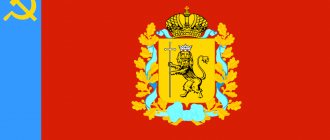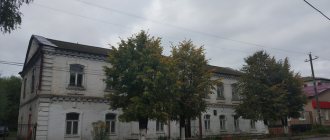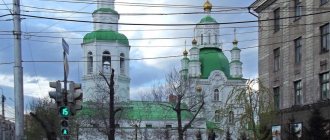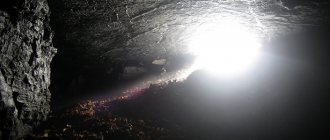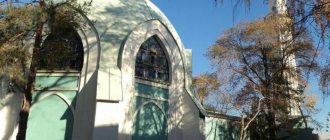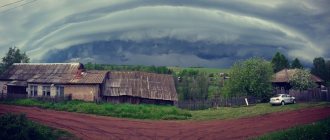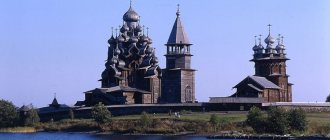LiveInternetLiveInternet
Nolinsk is a small town in the Kirov region, located on the banks of the Voya River, 137 kilometers south of the regional center. The area of the settlement is 6.3 square kilometers. The population of Nolinsky district is 9,720 people. City since 1780.
City coat of arms.
Panorama of Nolinsk at the beginning of the twentieth century
In 1612, on the banks of the river. Voi, not far from the confluence of the Nola River (which means drying up), the construction of the Vyatka Assumption Trifonov Monastery began. At the foot of the steep hill, where the springs flowed, the monastery peasants cut down the first huts of the churchyard. As the encyclopedia of the Vyatka land says, the development of vast uninhabited lands has begun.
In 1668, the construction of the stone St. Nicholas Monastery Cathedral was completed, and the churchyard began to be officially called the village of St. Nicholas. 1668 is the date of foundation of the Nikolsky churchyard, behind which the name of the village of Nikolskoye (Noli) was established. Until 1764, the village belonged to the Vyatka Assumption Trifonovsky Monastery.
In 1799, with the approval of the Vyatka governorship, by decree of Catherine II, the village of Nikolskoye (Noli) was transformed into the city of Nolinsk.
From 1780 to 1929, the center of the Nolinsky district of the Vyatka province.
In 1823 the city suffered from a severe fire, but quickly recovered.
In 1856, in the district town of Nolinsk, Vyatka province, there were 4 churches, 458 houses, 60 shops. In 1871, there were 14 factories in the city, including 2 tanneries, 3 lard factories, 4 gingerbread factories, and 5 vodka factories.
Pre-revolutionary Nolinsk was a city not only of merchants and artisans, but also of political exiles. So in 1898, F.E. Dzerzhinsky was in exile here. The city gave the world such famous people as: N. S. Kurnakov, B. P. Chirkov, N. E. Fedoseev, G. K. Malandin.
On February 17 (March 1), 1908, the famous Ural expropriator Alexander Lbov was arrested in Nolinsk.
Between 1940 and 1957 the city was called Molotovsk in honor of the Soviet statesman Vyacheslav Molotov.
Names of city residents: Nolinchane, Nolinchanin, Nolinchanka.
The name of the city was given by this river Nolya
Nolinsk on old photos and postcards
Attractions
The historical development of the city center is an object of historical and cultural heritage of the Kirov region. Architectural monuments include:
The building occupied by kindergarten No. 4 (the former building of the zemstvo government);
Pharmacy building No. 7, previously owned by the merchant Onimifor Mikhailovich Gyrdymov, sold to the zemstvo;
The building of the central regional library, previously owned by the merchant Evlampy Nelyubin;
St. Nicholas Cathedral;
Assumption Church;
The building of a children's art house, previously owned by the merchant Sergei Petrovich Polovnikov;
The military registration and enlistment office building, which previously belonged to the district architect S.P. Bratukhin;
Repair plant building, formerly a tobacco and tobacco factory;
The building of the House of Crafts, previously owned by the merchant Burov. An ensemble of wooden architecture with characteristic wooden lace;
The building of a childhood home (school orphanage), previously owned by the merchant Polovnikov;
In Nolinsk there is a house-museum of V. M. Molotov (in which Vyacheslav Mikhailovich spent his childhood and youth) and a museum of history and local history.
On Spartak Street in Nolinsk there is house No. 13, where Vyacheslav Scriabin (Molotov) spent his childhood. He was born in 1890 near Nolinsk, in the settlement of Kukarka, the current regional center of the Kirov region, Sovetsk, but he was taken from there in 1898, when he was still small. In 1937, the Molotov Museum was opened in the house, which existed until 1957. After 1957, the building housed a nursery, from the mid-seventies a boarding school, and in the nineties primary classes.
In 2004, the house was transferred to Vyacheslav Nikonov, Molotov’s grandson. Nikonov said: “For the last six years, no one has lived there, and during this time all the windows, doors were broken there, even nothing was left of the roof...”. In 2007, the house was renovated, and a Molotov Museum was opened in part of the house.
Former religious school, later school No. 2. Now the building houses the Muay Thai Federation
Former religious school
The famous actor Boris Chirkov, who played the role of Maxim in the thirties, was also from Nolinsk. The house where Boris Chirkov spent his childhood has been preserved.
The house where Boris Chirkov lived
In the real school of the city, in 1911-1919. future People's Artist of the USSR Boris Petrovich Chirkov studied.
Museum exposition
Assumption Church and monument to those who fell in the Great Patriotic War.
St. Nicholas Cathedral in ruins
Nicholas Cathedral. The stone temple was built in 1724, in 1725. The church was consecrated in the name of St. Nicholas the Wonderworker and services began in it. The bell tower was built in 1747, in 1898. The old stone bell tower was dismantled and a new one was built, which has survived to this day. In 1786, the Nolinskaya Church became a Cathedral. Over the course of many decades, work was carried out to rebuild and rebuild the temple. In 1937 St. Nicholas Cathedral was closed. (“Orthodox Nolinsk,” book by priest Vladimir Vasilyev). The temple has been restored by volunteers since 2010. In 2015 the dome of the temple was consecrated and a cross was erected. The temple is assigned to the Assumption Cathedral in Nolinsk, and services are held in the temple.
On the side of the road there is a large poster with an old photograph showing what the cathedral was like before 1917. Apparently they are going to restore it.
The collapsing gates of a city estate.
Contrasts of the city of Nolinsk
Monument to the Children of Leningrad
Soviet period sculptures
In Matryoshkin's park
Matryoshka from the Nolinsk matryoshka factory “Lyubushka”, inlaid with straws.
Nolinsky Kolobok (souvenir from the nesting doll factory of Vyatsky Souvenir CJSC)
A resident of the Nolinsky district became the best baker in the region. Lyudmila Kholstinina works at the Nolinsky Bread enterprise and, in addition to traditional baked goods, creates edible paintings. With the panel “150 years of consumer cooperation,” the woman took first place in the competition “Best Baking Master - 2020.”
Russian song ensemble “Nolyanochka”
Urban development of the late 19th century
The estate of the merchant Evlampy Nelyubin, now the Nolinskaya Central District Library (since 1911), a historical and cultural monument of regional significance. Urban development of the late 19th century.
Urban development of the late 19th century
Military registration and enlistment office. The former estate of the family of architect Pyotr Bratukhin.
Kindergarten No. 4 “Rainbow.” Located in an ancient building. The house was built in 1885. Susloparov Apollos Papovich, a well-known merchant and philanthropist in the city. He handed it over to city authorities. Previously, it housed the Zemstvo Council, the House of Soviets, and a school. The building will be restored in 2022.
Former school No. 1, now a store
Workers of the Nolinskaya pharmacy, 1910.
Tobacco shag factory of the Trading House "Ya.E. Nebogatikova's Sons", Nolinsk. In the center (with a beard) is Ya.E. Nebogatikov - the grandfather of the USSR Minister of Foreign Affairs Vyacheslav Molotov, the great-grandfather of the People's Artist of the USSR B.P. Chirkov.
The House for arts and crafts for children. Architect Pyotr Bratukhin.
Former school No. 1, a former real school, where the future People's Artist of the USSR Boris Petrovich Chirkov studied.
Late 19th century house
Entrance to the local history museum
Late 19th century building
On the streets of the city with old buildings
Museum exposition
Spring city streets are buried in lilacs
Nolinsk of the Soviet period.
When in August 1918 the First Moscow Regiment, which arrived in Urzhum to collect food surplus, rebelled, its commander, former officer Stepanov, led the regiment from Urzhum to Nolinsk. Some of the Nolin communists did not have time to escape and locked themselves in the building of the former religious school. They began to shoot back, but there were many windows in the building, it was impossible to keep track of them all, so when kerosene was pumped into the first floor and set on fire, the resistance stopped. Some surrendered, some fled but were caught, some managed to escape. Seventeen people were killed, among them the military commissar of Nolinsky district Andrei Vikharev, born in 1892. A little to the side is another board with the text “Historical Monument. In this building, on May 1, 1918, the first Nolinsk city meeting of the Bolsheviks was held on the current situation, the strengthening of Soviet power and the growth of party ranks. The organizers of the Bolshevik meeting were the military commissar of Nolinsky district Vikharev A.D. and political commissar Monakhov-Manuilov A.M. In the same building, on August 16, 1918, in the fight against the Stepanovite White Guards, the military commissar of Nolinsky district, A.D. Vikharev, died.”
A guard company of Red Army soldiers in 1918.
The first composition of the Nolinsky state stable. 1935. Photo from the archives of the Museum of History and Local Lore of Nolinsk.
Demonstration in honor of International Workers' Day, May 1, 1937. Assumption Square.
The modern building (treasury) was built taking into account the architectural traditions of the city.
Nolinsky contrasts
Cinema "Spartak" on Spartak Street. It has been closed for a long time and is in disrepair.
Nolinsky Ugor
Source 1 Source 2 Source 3
Links[edit]
Notes[edit]
- ^ abcdefgh Law No. 203-ZO.
- ^ a b Federal State Statistics Service (2011). All-Russian Population Census 2010. Volume 1 [All-Russian Population Census 2010, vol. 1]. All-Russian Population Census 2010 [All-Russian Population Census 2010] (in Russian). Federal State Statistics Service.
- "26. The size of the permanent population of the Russian Federation by municipalities as of January 1, 2022". Federal State Statistics Service. Retrieved January 23, 2022.
- ^ abcde Law No. 284-ZO
- "On the Calculation of Time". Official Internet portal of legal information
. June 3, 2011. Retrieved January 19, 2022. - Post office. Information and computing center of OASU RPO. ( Post office
).
Search for postal service objects ( postal Search for objects
) (in Russian) - ↑
Federal State Statistics Service of Russia (May 21, 2004). The population of the Russian Federation, cities of the Russian Federation as part of federal districts, urban settlements, settlements, settlements, settlements is 3 thousand or more people. [Population of Russia, its federal districts , subjects of the Federation, districts, urban settlements, rural settlements - administrative centers and rural settlements with a population of more than 3000 people] (XLS). All-Russian Population Census of 2002 [All-Russian Population Census of 2002] (in Russian). - All-Union Population Census of 1989 Population of Union and Autonomous Republics, Autonomous Regions and Districts, Territories, Regions, Urban Settlements and Village District Centers [All-Union Population Census of 1989: Current Population of Union and Autonomous Republics, Autonomous Regions and Districts, Territories, Regions , districts, urban settlements and villages performing the functions of district administrative centers]. All-Union Population Census of 1989 [All-Union Population Census of 1989] (in Russian). Institute of Demography of the National Research University: Higher School of Economics [Institute of Demography of the National Research University: Higher School of Economics]. 1989 - via Demoscope Weekly
.
Nolinsk
(Kirov region)
OKATO code:
33227501
Founded:
1668
City since:
1780 City of district subordination (Nolinsky district, Kirov region)
Center:
Nolinsky district
The city was formerly called:
| Nolinsk | 1940 | |
| Molotovsk | 1940 | 1957 |
| Telephone code (reference phone) | |
| 83368***** | 22-2-22 |
Deviation from Moscow time, hours:
0
Geographic latitude:
57°33′
Geographic longitude:
49°56′
Altitude above sea level, meters:
110 Sunrise and sunset times of the Sun and Moon in the city of Nolinsk
Climate
| Climate of Nolinsk | |||||||||||||
| Index | Jan. | Feb. | March | Apr. | May | June | July | Aug. | Sep. | Oct. | Nov. | Dec. | Year |
| Absolute maximum | 5,3 | 4,6 | 11,4 | 26,1 | 34,5 | 36,0 | 37,8 | 36,2 | 30,8 | 22,4 | 10,2 | 7,3 | 37,8 |
| Average maximum, °C | −10,2 | −8,8 | −1,5 | 8,2 | 16,9 | 21,5 | 23,7 | 21,3 | 14,2 | 5,7 | −2,8 | −8 | 6,7 |
| Average temperature, °C | −12,9 | −12,1 | −5,1 | 3,7 | 11,8 | 16,5 | 18,9 | 15,9 | 10,0 | 2,6 | −4,9 | −10,4 | 2,8 |
| Average minimum, °C | −16,7 | −16 | −9,2 | −0,8 | 6,2 | 11,1 | 13,8 | 11,3 | 6,0 | −0,2 | −7,6 | −13,8 | −1,3 |
| Absolute minimum, °C | −45 | −41,1 | −32,2 | −25 | −7,8 | −1,1 | 3,9 | 0,0 | −4 | −19 | −31,1 | −48 | −48 |
| Precipitation rate | 47 | 35 | 30 | 38 | 47 | 76 | 72 | 64 | 62 | 69 | 56 | 52 | 647 |
| Source: [climatebase.ru/station/27393/ Nolinsk, Russian Federation]. Archive of climate data. [www.webcitation.org/67g5FszWV Archived from the original on May 15, 2012]. | |||||||||||||
Population
| Population | ||||||
| 1856[3] | 1897[3] | 1913[3] | 1926[3] | 1931[3] | 1939[3] | 1959[4] |
| 2900 | ↗4800 | ↗5100 | ↗5600 | ↗6100 | ↗8500 | ↗10 326 |
| 1970[5] | 1979[6] | 1989[7] | 1992[3] | 1996[3] | 1998[3] | 2000[3] |
| ↗11 391 | ↗11 637 | ↘10 902 | ↘10 700 | ↗10 900 | ↘10 800 | →10 800 |
| 2001[3] | 2002[8] | 2003[3] | 2005[3] | 2006[3] | 2007[3] | 2008[9] |
| ↘10 700 | ↘10 463 | ↗10 500 | ↗10 700 | →10 700 | ↘10 500 | ↘10 400 |
| 2009[10] | 2010[11] | 2011[3] | 2012[12] | 2013[13] | 2014[14] | 2015[15] |
| ↘10 310 | ↘9554 | ↗9600 | ↗9697 | ↗9782 | ↗9794 | ↘9752 |
| 2016[1] | ||||||
| ↘9703 | ||||||
